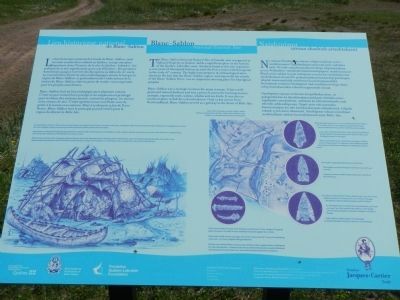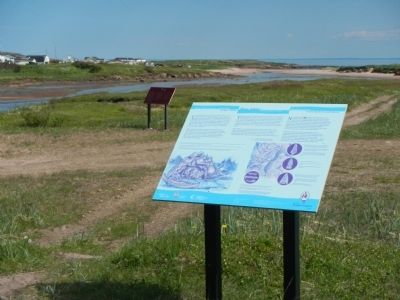Near Blanc-Sablon in Le Golfe-du-Saint-Laurent, Québec — Central Canada (French-Canadian)
Blanc-Sablon National Historic Site
Lieu historique national de Blanc-Sablon
— Naishipiunt utenau shashish aitashtakanit —

Photographed By Barry Swackhamer, June 27, 2014
1. Blanc-Sablon National Historic Site Marker
Captions (English / French): (clockwise from the upper left) Research has revealed that Aboriginal people lived here in oval tents with wooden frames covered with skins of bark, similar to the tipi. Over the past 2,000 years they also lived in an elongated (long house) tents that could house several families for months at a time. / Les Amérindiens vivaient ici dans des tentes ovales dotées d’une armature de bois couverte de peaux ou d’écorces, semblables au tipi. Au cours des deux millénaires, il ont également véce dans des tents allongées (maisons commune) que abritaient plusieurs familles pendant des mois entiers.; Territory included within the Blanc-Sablon National Historic Site, / Limite du lieu historique national de Blanc-Sablon.; (Arrow points, right side, top to bottom) 5,000-year-old quartz arrowhead. A stone tool from the Maritime Archaic Tradition which characterised the first five millennia of Aboriginal presence in the region. / Pointe de quartz datant de 5 000 ans. Un outil de pierre de la tradition de l’Archaique maritime, une tradition que caractérise les cinq premiers millenaries de la présence autochtone dans la région.; Paleioeskimo arrowhead dating from between 3,000 and 1,500 years ago. / Pointe paléo-esquimaude datant de 1500 à 3000 ans.; An Aboriginal chert arrowhead from Newfoundland, 500 to 700 years ago. One of the artefacts that testify to a vast trading network that stretched from Northern Labrador to Southern Ontario. / Une point en chert de Terre-Neuve datant de 500 à 700 ans. Un des artéfacts attestant de l’existence d’un vaste d’échanges s’étendant du nord du Labrador jusqu’au sud de l’Ontario.; (bottom, center) Nail used to build wharves and stages. Part of the remains of an 18th century French fishing wharf and a 19th century English fishing installation. / Cous servant à bâtir des quais et les chafauds ou plateformes. Un des vestiges d’un quai de pêche français du 18ᵉ siècle et d’une installation de pêche anglaise du 19ᵉ siècle.
The Blanc-Sablon National Historic Site of Canada, also recognised as Cultural Property in Québec, holds a signifiant place in the history of the Quebec- Labrador coast. Artefacts found at this site represent 9,000 years of Aboriginal history up until the first contact with Europeans in the early 16th century. The high concentration of archaeological sites attests to the fact that the Blanc-Sablon region, and especially the mouth of the Blanc-Sablon River, was an important meeting place for Aboriginal peoples.
Blanc-Sablon was a strategic location for many reasons. It has a well protected natural harbour and was a prime location for hunting marine animals, especially seals, walrus, whales and sea birds. It was also an excellent place to fish for cod and salmon. Only 15 km across from Newfoundland, Blanc-Sablon served as a gateway to the Strait of Belle Isle.
French:
Le lieu historique national du Canada de Blanc-Sablon, aussi reconnu comme bien culturel au Québec, occupe une place importante dans l’historie de la côte du Québec-Labrador. Les artéfacts de ce site représentent 9 000 ans d’histoire: des premiers Autochtones jusqu’à l’arrivée des Européens au début du 16ᵉ siècle. La concentration élevée de sites archéologiques atteste le fait que la région de Blanc-Sablon, et particulièrement l’embouchure de la rivière de Blanc-Sablon, était un point de rendez-vous important pour les peuples autochtones.
Blanc-Sablon était un lieu stratégique pour plusieurs raisons. C’était up port naturel bien protégé et un emplacement privilégié pour la chasse des animaux marins, surtout le phoques, les morses et les oiseaux de mer. C’était également une excellente zone de pêche à la morue et au saumon. Situé à seulement 15 km de Terre-Neuve. Blanc-Sablon était le principal point d’entree pour la région du détroit de Belle Isle.
Innu-aimun or Montagnais:
The right side of the marker has the Blanc-Sablon text in Innu-aimun. If you are interested, click on the marker image to enlarge it and read the text.
Erected by Fondation Québec-Labrador Foundation.
Topics. This historical marker is listed in these topic lists: Anthropology & Archaeology • Native Americans • Settlements & Settlers.
Location. 51° 25.712′ N, 57° 8.775′ W. Marker is near Blanc-Sablon, Québec, in Le Golfe-du-Saint-Laurent. Marker is on Boulevard Docteur-Camille-Marcoux, on the right when traveling north. Touch for map. Marker is at or near this postal address: 1554, Blanc-Sablon QC G0G 1C0, Canada. Touch for directions.
Other nearby markers. At least 1 other marker is within walking distance of this marker. Blanc-Sablon (a few steps from this marker).
More about this marker. This marker is on the southwest side of the bridge over the Blanc-Sablon river.
Also see . . . Blanc-Sablon National Historic Site of Canada. Blanc-Sablon was designated a national historic site of Canada in 2007 because: - with evidence of steady occupation for close to nine thousand years, Blanc Sablon is a trove of Aboriginal history along the coastline of the Quebec-Labrador peninsula; - more than 60 archaeological sites reflect the changes that occurred in Aboriginal societies in this region, in particular changes in habitation, settlement and subsistence; - the abundance and variety of wildlife remains are indicative of the importance of coastline resources - particularly seals - beginning with the Middle Post-Archaic Period, in the livelihood of the Aboriginal people who frequented the Blanc Sablon region. (Submitted on December 11, 2014, by Barry Swackhamer of Brentwood, California.)
Credits. This page was last revised on April 18, 2021. It was originally submitted on December 11, 2014, by Barry Swackhamer of Brentwood, California. This page has been viewed 479 times since then and 13 times this year. Photos: 1, 2. submitted on December 11, 2014, by Barry Swackhamer of Brentwood, California. • Andrew Ruppenstein was the editor who published this page.
